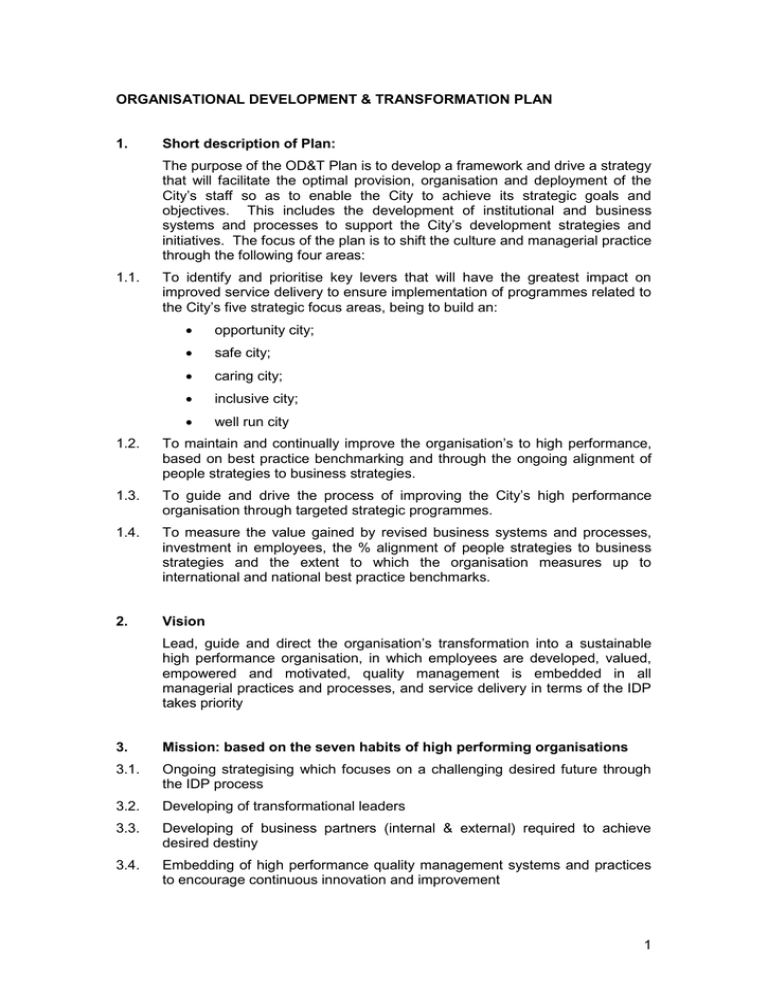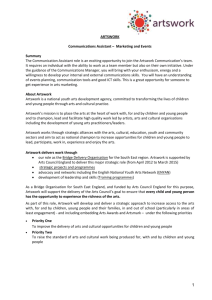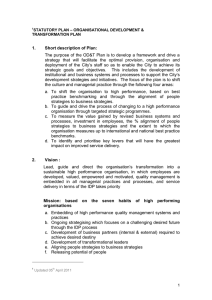The purpose of the OD&T Plan is to develop a... that will facilitate the optimal ... ORGANISATIONAL DEVELOPMENT & TRANSFORMATION PLAN
advertisement

ORGANISATIONAL DEVELOPMENT & TRANSFORMATION PLAN 1. Short description of Plan: The purpose of the OD&T Plan is to develop a framework and drive a strategy that will facilitate the optimal provision, organisation and deployment of the City’s staff so as to enable the City to achieve its strategic goals and objectives. This includes the development of institutional and business systems and processes to support the City’s development strategies and initiatives. The focus of the plan is to shift the culture and managerial practice through the following four areas: 1.1. To identify and prioritise key levers that will have the greatest impact on improved service delivery to ensure implementation of programmes related to the City’s five strategic focus areas, being to build an: opportunity city; safe city; caring city; inclusive city; well run city 1.2. To maintain and continually improve the organisation’s to high performance, based on best practice benchmarking and through the ongoing alignment of people strategies to business strategies. 1.3. To guide and drive the process of improving the City’s high performance organisation through targeted strategic programmes. 1.4. To measure the value gained by revised business systems and processes, investment in employees, the % alignment of people strategies to business strategies and the extent to which the organisation measures up to international and national best practice benchmarks. 2. Vision Lead, guide and direct the organisation’s transformation into a sustainable high performance organisation, in which employees are developed, valued, empowered and motivated, quality management is embedded in all managerial practices and processes, and service delivery in terms of the IDP takes priority 3. Mission: based on the seven habits of high performing organisations 3.1. Ongoing strategising which focuses on a challenging desired future through the IDP process 3.2. Developing of transformational leaders 3.3. Developing of business partners (internal & external) required to achieve desired destiny 3.4. Embedding of high performance quality management systems and practices to encourage continuous innovation and improvement 1 3.5. Aligning people strategies to business strategies and service delivery, ensuring core business processes are structured to delight communities 3.6. Releasing the potential of people 3.7. Powerful branding that identifies and energises what the organisation stands for. 4. Key strategic impacts and challenges 4.1. External factors impacting on the City: Global, national and local economic climate Rapid urbanisation – leading to increased demand on City services (e.g. housing, water and sanitation) and bulk infrastructure Decrease in CCT revenues linked to expanding population without equivalent expanding rates base & declining proportional share of national revenues Higher expectancy levels of clients and employees, as evidenced by high levels of community protest and employee disputes. Declining pool of graduates and related skills within the national and international labour market Constraint or limitation of legislative framework and its impact on local government 4.2. Key strategic challenges : Ensure quality and affordability of service delivery within an increasingly constrained economic and/or environmental climate through: o streamlining institutional frameworks, business systems and processes; o enhancing human capital development and management; o promoting quality management and productivity improvement. Provide sustained value for money in the delivery of services Accelerate the focus on establishing buy in from organisation to accept new ways of thinking, functioning and service delivery. Strengthen inter-governmental alignment, linkages and service delivery Promote positive changes to legislation 5. Critical success factors 5.1. Leadership commitment, buy-in to and ownership of Organisational and Transformation Plan. 5.2. Creating change in climate and culture through change management interventions. 5.3. Implementation of quality management framework. 5.4. Implementation of human capital management system. 6. Key performance Outcomes Indicators Executive Management Team to approve and update, on an annual basis, the appropriate outcome measures and to incorporate into the Corporate Scorecard or the Directorate and Departmental SDBIPs, as deemed appropriate. The outcome indicators will ideally include measures for: 2 6.1. Customer Satisfaction Citywide surveys and rankings in relation to national or international surveys 6.2. Operational Efficiency shall be measured as: Responsiveness (composite indicator) Staff utilization (composite indicator) Talent Development (composite indicator) Reduction in % resignations in scarce skills. Coupled with succession plans Reduction in legal risk arising from non-compliance in OHS Number of external training opportunities created 6.3. Staff Engagement As measured by biennial surveys Employment equity (composite indicator) 6.4. Governance Clean audit City’s credit rating Ranking in relation to national service delivery surveys Establishment of electronic storage of City’s information and knowledge to allow for easy access, sharing and distribution of information and knowledge 7. STRATEGIES The strategies are all supported by Change Management and Communication Plan 7.1. Strategy 1: Development and implementation of institutional frameworks and business systems to ensure delivery of IDP. Programmes: Institutional Operational Model including: o District Service Delivery Model o Integrated service centres o Call centre/CRM strategy o Sub-council participatory mechanisms ICT programme Implementation of the Organisational Development Framework Service Management Programme Information and Knowledge Management Framework 7.2. & Design Strategy 2: Implementation of human capital management systems and processes to enhance staff alignment to business needs and to improve staff morale and performance Programmes Human Capital Management Programme e-HR Programme 3 7.3. Strategy 3: Implementation of efficiency and effectiveness gains interventions through business improvement initiatives Programmes Quality Management Capacity Building Programme Business Improvement Programmes, including o Management Accountability Programme (improve management accountability for core business processes within the City) o Property Value Chain Programme (further enhancements to optimise the investment in the ISIS project) o Customer Information Programme (single view of customer, regulating the creation & maintenance of ‘business partners’ on SAP) o Other identified departmental & directorate functional areas 8. Outcomes 8.1. Improving customer - community and business - satisfaction (internal & external) with CCT service delivery 8.2. Improving the operational efficiency and effectiveness of the organisation 8.3. Improving employee engagement index rating 8.4. Improving governance 4






